As the water and weather become warmer, mangrove jacks become part of the estuary equation north of Coffs Harbour.
SECTION: features
MAPS:
Facts
ILLUSTRATIONS: 0
The air felt hot and sticky as we pushed the 4.2m tinny off the trailer and after quickly parking my tow vehicle, I jumped on board. The sun was just disappearing behind the hills as I stuck the boat’s nose into the main river.
The sounder told us the water was 25.7° and we could see a storm brewing inland. We could smell the mangrove jacks in the air!
Kevin and I quickly rigged up our rods with hard-bodied minnows in the last few moments of the fading light and headed to one of our favourite spots a short drive up-river. The spot was a short rock bar in about 4m that ran out into the channel from one of the rocky points. A prime depth when towing for jacks. I slowed down a short distance from the rock bar and idled up to it. I could see a few patches of bait on the sounder and with great anticipation we dropped our lures over the side.
I idled down the length of the rock bar with knuckles whitening as I hung onto the rod, ready to react to the crunching hit of a jack. We had just about reached the end of the troll when I felt a small tap but no hook-up. I immediately dropped the rod back and free-spooled a bit of line to try to keep the lure in front of the fish.
The braid came tight again and I gave the rod tip a couple of flicks, trying to give the impression that the first hit had ‘injured’ the lure. The result was explosive, with the rod almost pulled out of my hand.
I reared back on the rod, trying to get the tip up, and frantically gunned the motor towards the safety of the channel. Everything held together and I managed to drag the fish away from its rocky home.
It was a brutal fight and within minutes the fish was lying in the net. Careful to avoid the jack’s dog-like fangs, I removed the heavy-duty trebles. The fish went 53cm and after a few photos was released to terrorise the local herring population. Mission accomplished!
There are many ways to target mangrove jacks but trolling has to be one of the most exciting methods. It is also very productive because of the amount of water you can cover.
I have developed a few jack trolling tricks through trial and error, (the error normally being the loss of another favourite lure!) that help me to consistently catch these amazing fish. Some of these techniques might be old news to the more experienced but, as is the case with fishing, we are constantly learning new tricks.
Top of the list is definitely the rod and reel used. I make a point of fishing for these tough fish with tackle as heavy as I can. I land many more fish because of this and when I release them they are not exhausted from the battle.
My weapon of choice is a Samurai NV7 blank that I had custom-built to 5’8”. This rod is rated 8kg to 10kg and is an absolute beast around the butt section but has enough tip to be able to feel the beat of my minnow change when it has picked up a bit of weed.
I fish a Daiwa Black Sheep baitcaster loaded with 30lb braid and my drag gets backed off only when I put the rod back on its stand in the garage. The length of the rod is quite important, you don’t want it too long because there is too much leverage when a big jack hits. This makes it very difficult to get the rod up again and cost me a few lures before I went to a shorter rod.
Yes, you can catch jacks on lighter gear and many people do but since I upgraded to such a heavy outfit I have landed all the big jacks I have hooked. I would rather land the fish and release it unhurt than have it bust me off and swim away with two heavy-duty trebles and a hard lure in its gob.
When you get hit by a jack on the troll, the fish must be turned immediately; it cannot be allowed to take even one metre of line. I keep my rod tip close to the water as I troll and when I get a hook-up I try to lift the rod up as high as possible – sometimes a very tough ask when a big jack is trying to drag you off the back of the boat.
The higher rod angle helps to keep the line away from the barnacle-encrusted snags. At the same time, I gun the motor to move the boat away from the snag. Once again your tackle is tested to the limits so rather go heavy. If your gear is up to it then you should get the fish out into open water.
Many fishos come undone here; they think they can relax and back the drag off. Never let up on a jack! Go hard from start to finish. If you back off and let the fish gets its head, it will end up towing you back to the snag and busting you off. The fish is landed only when it is in the net.
Leader material always seems to bring up a debate. Fluorocarbon is not a necessity because most jack fishing is done in low light periods and fluorocarbon needs the sun’s rays to be effectively invisible. It is also very expensive and because of the terrain where you fish for jacks, you will find yourself going through a fair amount of leader. I really don’t have a preference on manufacturers and literally use whatever I have at the time.
The one aspect of leaders that I do pay special attention to is the thickness. The thickness of my leader depends on how much run there is in the water and the depth I want my lure to operate.
Most trolling for jacks is done against the tide to slow down the boat and to keep the lure in the strike zone longer. The leader you use will have a certain amount of resistance in the water and will therefore lift the lure higher in the water column.
If I am towing into the tide then I will try not to go over 40lb mono, my standard choice is 35lb if I really want my lure to get down or if the tide is really ripping. I upgrade my leader thickness as the tide slackens. I always fish as heavy as possible without affecting the lure’s action. It might sound like a minor detail but believe me, it does make a difference.
The lures you tow also play a big role. When I started trolling for jacks I thought it was just a case of tying on a minnow, tossing it out and the fish would jump on. Hours of fruitless trolling soon taught me otherwise.
The majority of towing gets done in 3m to 5m of water, unfortunately a very difficult depth to find a lure to swim in. The majority of minnows on the market dive to 3.5m or slightly deeper with braid. If you add a fair amount of current and a 50lb leader to the equation then these lures are back up around 3m swimming depth.
If you want to go deeper, the next bet is something like the Mann’s 20+. The problem here is that it sometimes will run too deep, banging into the bottom too much and resulting in your leader getting chewed up and a lot of missed jacks.
If you picture the lure banging into the bottom, the only place a fish can hit it is from above. This normally results in a hard hit but no hook-up. When the lure is retrieved and inspected you will normally see a nice set of teeth marks on top of the lure’s head.
To get past these problems I have settled on a few lures and methods to keep them in the strike zone. When the tide is really ripping, I tow the Stretch 20+ on a fairly thick leader (60lb); that way it will run just deep enough to touch bottom periodically. When the lure starts banging the bottom too much, I change to my favourite jack lure: The Lively Lures Mad Mullet.
I have found this lure to run at just the right depth and to be extremely tough. I run this lure on about 40lb leader to make work in that bottom 50cm of the water column.
The more you start to mess around with hardbodies, the better idea you will get of the depth they run. I like to get them to run just off the bottom so that the fish hit them from the side or below, normally resulting in a better hook-up.
The last piece of advice that I can offer is that these fish do not keep very sociable hours and at the end of the day, the best piece of gear is a reliable alarm clock placed well out of arm’s reach. My poor wife dreads the words: “I am going for a jack fish in the morning.”
This is a very close-quarters, brutal type of fishing and the tackle we use is most often overkill for the size of the fish we target. I do this for a reason, to hopefully increase my chances of landing and releasing these fish in good condition.
I have landed several good-size jacks which have sported lengths of mono line and hooks hanging out their mouths. It just emphasises the amount of pressure that is put on these fish through the warmer months.
Try to release the majority of these beautiful bulldogs of the rivers so that we can keep catching them. Hopefully some of this will help you to land the next smashing hit you get from a red devil.
Facts
HARDWARE
The first thing I do with a minnow is to upgrade the trebles to heavy-duty models before I swim them. Once again, this is a personal preference and a subject up for debate between fishos. I use the Gamakatsu heavy-duty Treble 16s because I have had excellent success with them. They are extremely sharp and I have not had one straightened.
One very important rule when changing trebles is to not use a bigger version than the original hooks. Rather, go smaller with heavy-duties to continue the approximate hook weight. You are replacing a lighter-gauge hook with a heavier one so it is more weight the lure has to move around. If you go too big then it alters the action of the lure and can turn a deadly lure into a useless piece of plastic.
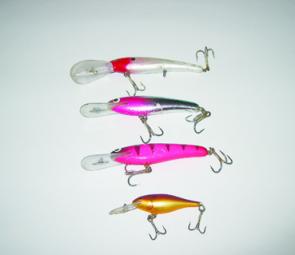
Some good lures for trolling rock bars and walls in 3m to 5m. From the top, Mann's 20+ , Lively Lures Mad Mullet in blue chrome and in pink, Rapala Shad Rap.SR8. Note the beefed-up trebles to cope with the brutal fight on heavy braid.
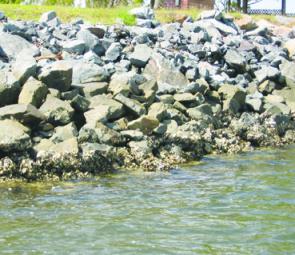
Rock walls like this are good places to look for jacks. Keep an eye on the sounder for bait schools, rubble on the bottom and rock bars.
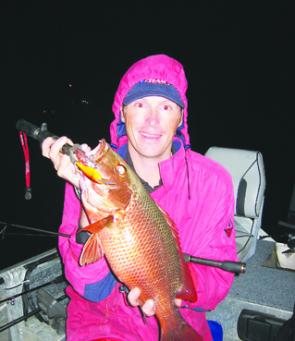
A 50cm jack caught trolling with 8lb braid and 10lb leader with a Rapala Shad Rap. After getting several half-hearted hits on heavy gear and large lures, the author took a gamble to downgrade the terminal tackle. Luckily, the fish ran out into the main ch
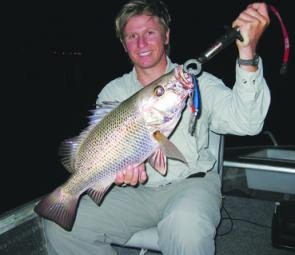
Franco Martinese with a 52cm jack trolled up on a Mann’s Stretch 20+ fished very short behind the boat to stop the fish from busting the lure off.
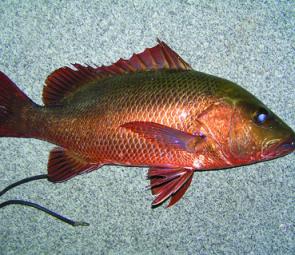
This is the culprit that makes the author get out of bed in the wee hours while normal people are still sound asleep.
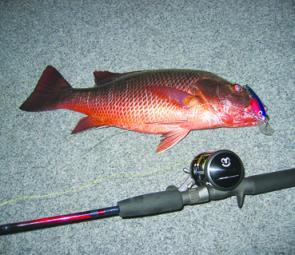
A good jack trolled up on a Lively Lures Mad Mullet. The pre-dawn hours and even after dark are prime times for keen-eyed jacks to be out patrolling.
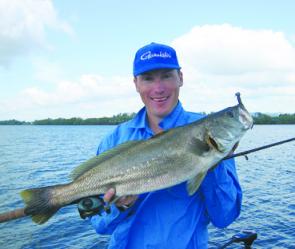
Sometimes other fish get in on the act, such as this school jew. The other prime candidate in deep water is the flathead.




